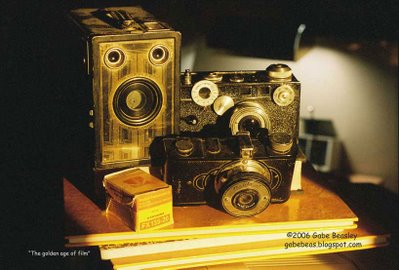 A few simple examples of my old camera collection. The one to the back right is a Cintar rangefinder that I still use. It is almost certainly over 50 or 60 years old. One of the first common 35mm cameras. It's complex manual controls make it easy to do trick photography and just take good pictures although you have to do several extra steps and you need a light meter to get good pictures for sure. These are a few of my large collection of cameras. I collect all kinds of them but usually only rangefinders or really old ones like these. It's incredible what you can still find in some thrift stores. Back in the early 1990s--you could easily find 1000s of dollars in many thrift stores that did not have an expert or intrernet ability to look up things. Still, rare books, cameras and even nice antueque radios can be found at a few thriftstores today. Lenses are great to look for.
A few simple examples of my old camera collection. The one to the back right is a Cintar rangefinder that I still use. It is almost certainly over 50 or 60 years old. One of the first common 35mm cameras. It's complex manual controls make it easy to do trick photography and just take good pictures although you have to do several extra steps and you need a light meter to get good pictures for sure. These are a few of my large collection of cameras. I collect all kinds of them but usually only rangefinders or really old ones like these. It's incredible what you can still find in some thrift stores. Back in the early 1990s--you could easily find 1000s of dollars in many thrift stores that did not have an expert or intrernet ability to look up things. Still, rare books, cameras and even nice antueque radios can be found at a few thriftstores today. Lenses are great to look for.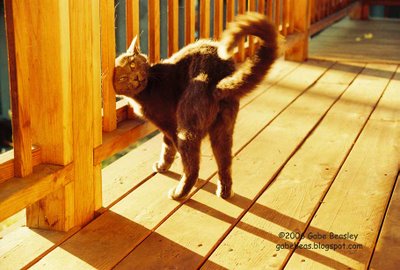 "Happy"
"Happy"My neighbor’s cat. I have never seen a cat so affectionate. He craves attention like a nice dog. Following me around as I take pictures in my yard. I finally took a liking to him despite his attacks on the backyard wildlife I like to photograph so much. I have never known a cat that will sit in your lap like this one does. Not afraid of the camera either--these are 35mm pictures taken with Vivid color Kodak Professional film (I found it at Freda Mayors available at least for now) The vivid colors were well worth the costs and to me better then "HD-High Definition" Kodak film. These pictures are not AT ALL digitally altered. Only my name stamp and downsizing for the Internet was done. They look just like this on the prints.

He is such a crazy cat, if you scratch his back he rolls around and looses his balance sometimes falling over on things! Out here, animals and people itch sometimes in the dry air. So scratching his back and head made him an He's as social as a lap-dog. Once again this a 35mm film shot I took a couple of months ago with Kodak Professional color film. The picture was taken with an Olympus is-50 SLR. 35mm film and film in general will never "die" as there are so many markets for it and also many people who protectively use it. It will become a bit like vinyl but more available. I estimate it will at least be easy to get for the next 50 years assuming there is no extreme global disaster. Film too expensive? Try having your film processed onto a CD only, often it is cheaper then getting 4x6 prints and you can pick out the one's you want printed later or on the spot if you enjoy your 35mm and other film cameras enough to want to keep using them in the digital age. Early on, picture disks and CDs were poor quality JPEG or BMP.
Now days, most all stores now run 300dpi Tiff files. That's high enough to make a far larger picture. From 1818x1228 to 2856x2142 brings you close to a 6mp camera sized file. I think they should measure in dpi and dimensions rather then mega-pixels--that measurement tells you what really what the camera is capable of doing. More then a sometimes changed generalized "mega-pixels". You lower the dpi but up the size to get better use of that much resolution. Just enlarge it and test the picture. You should be getting a TIFF CD and each file should be about 5 mega-pixcels. Files under 2mb are too small and your probably not going to an up to date store. Save the negatives, they can always be scanned at the lab for a new CD. Hang on to those negatives--you never know when you might want or need them.
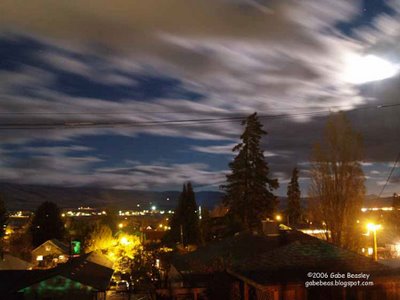 This is nearly my favorite type of pictures--night shots. Long exposures. I really like doing long exposures because you never really know what you will get until it's been taken. A long exposure is anything you can't possibly hold the camera for. Usually these are measured in seconds rather then the normal shutter scale starting at possibly 1/8th or 10. "B" stands for "bulb" and traditionally that function even in new digital SLR is called "bulb" or "b". As long as you can hold down the shutter--the camera will keep the shutter open. But that's not needed. Night can be turned into daylight in less then 30sec.
This is nearly my favorite type of pictures--night shots. Long exposures. I really like doing long exposures because you never really know what you will get until it's been taken. A long exposure is anything you can't possibly hold the camera for. Usually these are measured in seconds rather then the normal shutter scale starting at possibly 1/8th or 10. "B" stands for "bulb" and traditionally that function even in new digital SLR is called "bulb" or "b". As long as you can hold down the shutter--the camera will keep the shutter open. But that's not needed. Night can be turned into daylight in less then 30sec. I could have brought this up in Photoshop but I chose to leave it just how it is. This shot had very little light--in fact through my viewfinder I had a hard time focusing. I think this was a 30sec exposure but I'm not sure. The longest ones I did this night were about 50sec. Anything longer became an overexposure. The moon-lit night really is the best time--but shots I have taken in the early morning have been really nice as well. Morning fog at 1/8 to 30sec at f5.6iso 200 can turn out really cool. And if you can shoot well at 400+ without serious noise problems--try it for less time. Generally however the slower the iso the better composed the picture is--no matter how expensive your camera is. Digital cameras were built to emulate film but not some of the newer kinds of film which do very well above 400iso. I have not yet met a general digital compact or SLR that is not capable of doing some kind of a long exposure. Often limited to 15, 30 or 60sec they do still have this feature, especially if you have all manual controls. All these shots were done with a semi-pro digital SLR. But you don't need a thousand dollar camera to do shots like this. My Cannon A520 and my Kodak DX can do them as well. "B" or bulb mode is not very practical for any use other then flash-photography. When you open the shutter in darkness and fire off a manual operated flash--the poor man's way of getting good lighting on a macro shot!
I could have brought this up in Photoshop but I chose to leave it just how it is. This shot had very little light--in fact through my viewfinder I had a hard time focusing. I think this was a 30sec exposure but I'm not sure. The longest ones I did this night were about 50sec. Anything longer became an overexposure. The moon-lit night really is the best time--but shots I have taken in the early morning have been really nice as well. Morning fog at 1/8 to 30sec at f5.6iso 200 can turn out really cool. And if you can shoot well at 400+ without serious noise problems--try it for less time. Generally however the slower the iso the better composed the picture is--no matter how expensive your camera is. Digital cameras were built to emulate film but not some of the newer kinds of film which do very well above 400iso. I have not yet met a general digital compact or SLR that is not capable of doing some kind of a long exposure. Often limited to 15, 30 or 60sec they do still have this feature, especially if you have all manual controls. All these shots were done with a semi-pro digital SLR. But you don't need a thousand dollar camera to do shots like this. My Cannon A520 and my Kodak DX can do them as well. "B" or bulb mode is not very practical for any use other then flash-photography. When you open the shutter in darkness and fire off a manual operated flash--the poor man's way of getting good lighting on a macro shot! This is a digital shot, I perfected it more and more with lots of tests. There is no camera mode that does this (as usual). I have no idea how people get through using the "auto" or scene modes. To me--those modes are like adding another photographer who does everything by the book (if there was such a book). Doing things "by the book"--is often not a very good way to take pictures. So turn off your auto-pilot controls by switching to “M” mode, and open your shutter for 30sec. On a moonlit night--night can turn to day and the pictures can be incredible.
This is a digital shot, I perfected it more and more with lots of tests. There is no camera mode that does this (as usual). I have no idea how people get through using the "auto" or scene modes. To me--those modes are like adding another photographer who does everything by the book (if there was such a book). Doing things "by the book"--is often not a very good way to take pictures. So turn off your auto-pilot controls by switching to “M” mode, and open your shutter for 30sec. On a moonlit night--night can turn to day and the pictures can be incredible.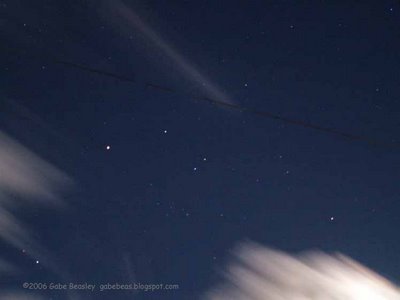 Stars move faster then you might think. Even in less then 1min exposures they can be seen to be moving and turn into lines--I got this one just on the edge of that effect. Many of these stars were not visible to me. It is confirmed that they are not noise. Tripod or camera shake can be a big problem with long exposures. My digital SLR has a feature called "anti-shock". This delays the shutter from opening in such a way that the mirror flips up but the shutter is not opened (an event to small to shake the camera) until a certain amount of time you can set it for. 1, 2, 10sec. If you don't have this feature you might try using the auto-timer like you would use if you want to take a picture of yourself when you are alone and don't have a remote control.
Stars move faster then you might think. Even in less then 1min exposures they can be seen to be moving and turn into lines--I got this one just on the edge of that effect. Many of these stars were not visible to me. It is confirmed that they are not noise. Tripod or camera shake can be a big problem with long exposures. My digital SLR has a feature called "anti-shock". This delays the shutter from opening in such a way that the mirror flips up but the shutter is not opened (an event to small to shake the camera) until a certain amount of time you can set it for. 1, 2, 10sec. If you don't have this feature you might try using the auto-timer like you would use if you want to take a picture of yourself when you are alone and don't have a remote control. Lights come from all over the place. I really like night pictures. Some compact cameras have a manual mode, and many models can take long exposures for over 15 sec. Set the timer to prevent shake-blurs and be sure to use a tripod. None of these long exposures were at all possible without a tripod. That dot out in the distance is not lens flare--it's actually an airport signal light in Dallesport. And that large Church steeple--I did not know it was lit up so much until I did these kinds of shots.
Lights come from all over the place. I really like night pictures. Some compact cameras have a manual mode, and many models can take long exposures for over 15 sec. Set the timer to prevent shake-blurs and be sure to use a tripod. None of these long exposures were at all possible without a tripod. That dot out in the distance is not lens flare--it's actually an airport signal light in Dallesport. And that large Church steeple--I did not know it was lit up so much until I did these kinds of shots. The moon casts it's bright light over The Dalles. This was an awesome night just before the full moon. Nights like this can be very fun. Just keep playing with your camera and turning night into day can be very possible. As see above, the white ballence is usually off and so everything has an orange or redish tint. Be ready to set your own white ballence.
The moon casts it's bright light over The Dalles. This was an awesome night just before the full moon. Nights like this can be very fun. Just keep playing with your camera and turning night into day can be very possible. As see above, the white ballence is usually off and so everything has an orange or redish tint. Be ready to set your own white ballence.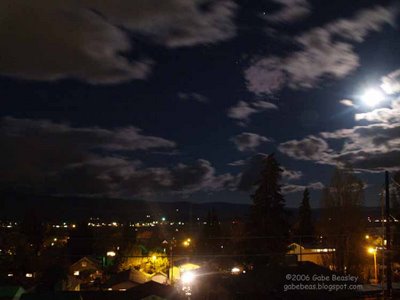 Clouds moved so fast that even in a quick exposure like 10sec at 200iso they can be seen to move in the moonlight. Exponent with longer exposures and you can get all kinds of stuff that turns night into day with very interesting results. I have an excellent picture of my house I am very proud of but I will not post it on my website.
Clouds moved so fast that even in a quick exposure like 10sec at 200iso they can be seen to move in the moonlight. Exponent with longer exposures and you can get all kinds of stuff that turns night into day with very interesting results. I have an excellent picture of my house I am very proud of but I will not post it on my website. A shot taken as the sun went down from my deck. This building is about three miles away and can hardly be seen without my 600mm scope which is still working very well and proving itself more and more every time I use it.
A shot taken as the sun went down from my deck. This building is about three miles away and can hardly be seen without my 600mm scope which is still working very well and proving itself more and more every time I use it. IMPORTANT
IMPORTANTDo not photograph ANY kind of plasma display or very high-voltage source with digital cameras in the area. This shot was taken from about 10ft away. The electrical field given out by any kind of plasma display or Tesla coil or static electricity generator, can quickly do serious damage to your digital cameras (including 35mm cameras with digital control systems). The same goes for high-static areas like taking cloths out of a dryer.. High voltage radiation can destroy cameras and gear so keep your distance from it! The same thing applies to some of these new high-powered walkie-talkies. These high-powered radios now sold everywhere put out enough power to scramble digital logic circuits at close range and damage parts. Another thing about this stuff--NEVER put a memory card in a plastic bag. Plastic bags, scotch tape and other stuff produces static electricity which could damage or destroy memory cards! I had to learn that one the hard way.
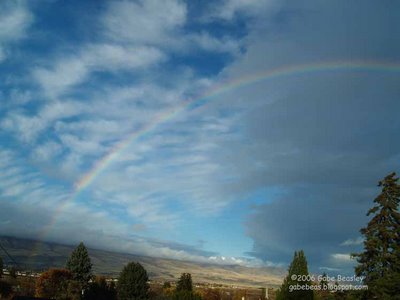 This incredible rainbow appeared as fast as it was gone. I just happened to be outside waiting for birds. All the sudden there it was--the largest rainbow I've ever seen in The Dalles. Thinking for what I have trained myself to think--I knew I had to change lenses to my widest for my digital SLR. I ran inside and did that--then ran past the power lines and my yard to get this shot in my socks! I got several shots this way--then realized I needed yet a wider lens and went to my Cannon with it's fish-eye lens I setup for it--the only way to see the entire rainbow in one picture. By the time I got back (in less then 2min) the rainbow was mostly gone. It only lasted for about 2-4min --I am thinking more like 2.
This incredible rainbow appeared as fast as it was gone. I just happened to be outside waiting for birds. All the sudden there it was--the largest rainbow I've ever seen in The Dalles. Thinking for what I have trained myself to think--I knew I had to change lenses to my widest for my digital SLR. I ran inside and did that--then ran past the power lines and my yard to get this shot in my socks! I got several shots this way--then realized I needed yet a wider lens and went to my Cannon with it's fish-eye lens I setup for it--the only way to see the entire rainbow in one picture. By the time I got back (in less then 2min) the rainbow was mostly gone. It only lasted for about 2-4min --I am thinking more like 2. The biggest Dalles rainbow I have yet to see. I went outside to spot a few birds when I saw this rainbow instantly appear in front of me---I ran into the house to get my general purpose lens and just ran down into the ally to get pictures without power lines. Wet socks or not--I want to get my shot!
The biggest Dalles rainbow I have yet to see. I went outside to spot a few birds when I saw this rainbow instantly appear in front of me---I ran into the house to get my general purpose lens and just ran down into the ally to get pictures without power lines. Wet socks or not--I want to get my shot! I took off so fast because I knew I only had a couple of minutes at best. I was able to get these three shots off which I might enhance a bit later. I had to run like a crazy guy to get these pictures. In my now muddy wet socks I had to run inside to change lenses because a 600mm lens is useless for a rainbow shot! Then I remembered my wide angle lens but by the time I came back outside the next time it was too late and I did not get one wide angle shot in. Rainbows happen here every year--but this one completed would have been a really cool shot only possible with a very wide angle lens. I built a nice fisheye for my Cannon now--but I was not ready to use it.
I took off so fast because I knew I only had a couple of minutes at best. I was able to get these three shots off which I might enhance a bit later. I had to run like a crazy guy to get these pictures. In my now muddy wet socks I had to run inside to change lenses because a 600mm lens is useless for a rainbow shot! Then I remembered my wide angle lens but by the time I came back outside the next time it was too late and I did not get one wide angle shot in. Rainbows happen here every year--but this one completed would have been a really cool shot only possible with a very wide angle lens. I built a nice fisheye for my Cannon now--but I was not ready to use it. I shot this rose from about 20ft away or so. I keep thinking to bring a rangefinder camera with me so I can truely see distances. I have two good ones that work out to 100ft. The main idea, with a 600mm macro lens you no longer have to tresspass or even be noticed taking a picture of the naighbors flowers or other things. It's an incredible system, but good lighting makes it possible to get very detailed shots from a distance as long as you take all the factors into mind and practice useing the slider focusing system and all-manual feel.
I shot this rose from about 20ft away or so. I keep thinking to bring a rangefinder camera with me so I can truely see distances. I have two good ones that work out to 100ft. The main idea, with a 600mm macro lens you no longer have to tresspass or even be noticed taking a picture of the naighbors flowers or other things. It's an incredible system, but good lighting makes it possible to get very detailed shots from a distance as long as you take all the factors into mind and practice useing the slider focusing system and all-manual feel. OUT OF PLACE this wolf spider with it's fast reflexes and high-mounted eyes was aware of me but cold enough that I was able to photograph it with my main macro lens (the Phoenix lens adapted to be the same lens I use for that above rose and the long distance shots of all kinds.) Wolf spiders are TINY here and there is no need to fear them. They run in great fear of you when they are not cold. We are allready getting our first frost out here. That is why I got this shot.
OUT OF PLACE this wolf spider with it's fast reflexes and high-mounted eyes was aware of me but cold enough that I was able to photograph it with my main macro lens (the Phoenix lens adapted to be the same lens I use for that above rose and the long distance shots of all kinds.) Wolf spiders are TINY here and there is no need to fear them. They run in great fear of you when they are not cold. We are allready getting our first frost out here. That is why I got this shot.